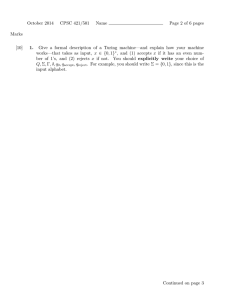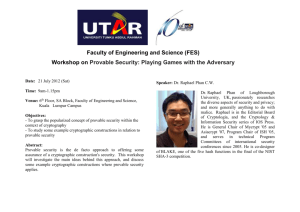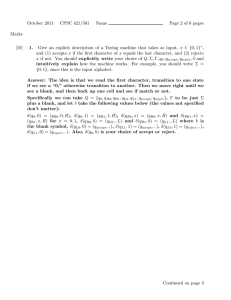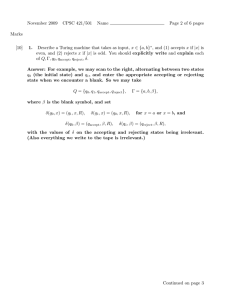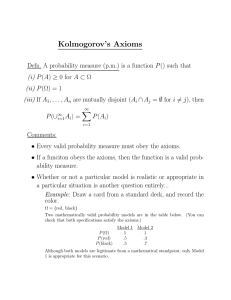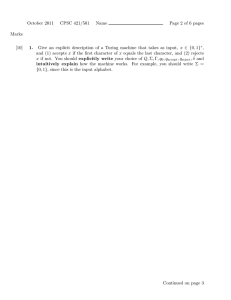October 2014 CPSC 421/501 Name Page 2 of 6 pages
advertisement
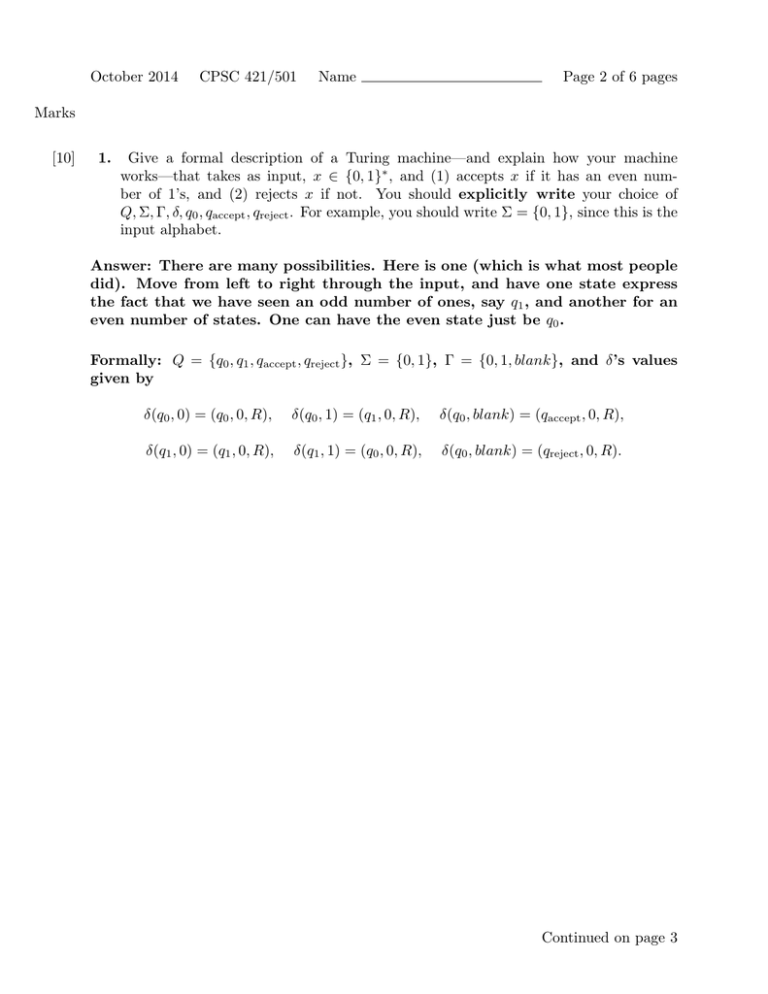
October 2014
CPSC 421/501
Name
Page 2 of 6 pages
Marks
[10]
1.
Give a formal description of a Turing machine—and explain how your machine
works—that takes as input, x ∈ {0, 1}∗ , and (1) accepts x if it has an even number of 1’s, and (2) rejects x if not. You should explicitly write your choice of
Q, Σ, Γ, δ, q0 , qaccept , qreject . For example, you should write Σ = {0, 1}, since this is the
input alphabet.
Answer: There are many possibilities. Here is one (which is what most people
did). Move from left to right through the input, and have one state express
the fact that we have seen an odd number of ones, say q1 , and another for an
even number of states. One can have the even state just be q0 .
Formally: Q = {q0 , q1 , qaccept , qreject }, Σ = {0, 1}, Γ = {0, 1, blank}, and δ’s values
given by
δ(q0 , 0) = (q0 , 0, R),
δ(q0 , 1) = (q1 , 0, R),
δ(q0 , blank) = (qaccept , 0, R),
δ(q1 , 0) = (q1 , 0, R),
δ(q1 , 1) = (q0 , 0, R),
δ(q0 , blank) = (qreject , 0, R).
Continued on page 3
October 2014 CPSC 421/501 Name
[16]
2.
Page 3 of 6 pages
(4 points for each part) Briefly justify your answers:
(a) Let P and I be any countably infinite sets and let “Result” be a function described
in Axiom 1. Are there languages, i.e., subsets of I, that are not recognized by
any element of P?
Answer: Since I is countably infinite, the set of languages is uncountable, and
hence any map from the programs to the set of languages cannot be surjective.
Hence there are languages not recognized by any program.
(b) Russell’s paradox involves considering “the set of all sets that do not contain
themselves.” What is the standard way of resolving this paradox?
Answer: The collection of sets with a some properties–including the collection
of all sets–is defined to be a “class” (which may be a set or something “larger”).
Remark: One often thinks intuitively that a set shouldn’t contain itself, but this
is not strictly necessary. However, a collection of sets as large as those “that
do not contain themselves” should not be a set (as can be seen by Russell’s
paradox). There are collections of sets that are sets, such as the power set of
a set. However, we still want to be able to speak about collections of sets such
as all sets, so some of these collections are “classes” but not “sets.”
(c) Assume that you have a set of axioms in a system of logic where you can construct
a sentence, S, whose meaning is “S is not provable (from the axioms).” Assume
that you have an interpretation of your sentences so that each sentence is either
true or false, but not both. Show that at least one of the following holds: (1)
Some sentence that is provable (from the axioms) is false, or (2) Some sentence
is true but not provable (from the axioms).
Answer: S is either true or false. If S is false, then—given the meaning of
S—S is provable (case (1)). Is S is true, then, similarly, S is not provable but
true (case (2)).
Remark: (1) can definitely hold: consider the case where the axioms consist
of all sentences (whether they are true or false under our interpretation).
(d) In class we showed that |S| < |P ower(S)| for any set S, where P ower(S) is the
set of all subsets of S. Our proof involved considering any map f : S → P ower(S),
and forming the set
T = {s ∈ S | s ∈
/ f (s)}.
How do we use this T and what assumptions do we make on f to show that
|S| < |P ower(S)|?
Continued on page 4
October 2014
CPSC 421/501
Name
Page 4 of 6 pages
Answer: If not, then there is a surjection f : S → P ower(S). Then, with T as
above, since f is a surjection there is a t ∈ S such that f (t) = T . But then either
(i) t ∈ T , or (ii) t ∈
/ T ; if t ∈ T , then by definition of T we have t ∈
/ f (t) = T ,
which is a contradition; similarly, if t ∈
/ T , then by definition of T we have
t ∈ f (t) = T , again a contradiction. Hence the assumption that such an f —i.e.,
a surjection—exists leads to a contradiction, and hence |S| < |P ower(S)|.
Continued on page 5
October 2014
[10]
3.
CPSC 421/501
Name
Page 5 of 6 pages
Let NO-COUNT-3 be the language of descriptions, hp, ii, consisting of a 421Simple
program, p, and an input, i, such that p has a variable named COUNT, and when p
is run on input i, the variable COUNT that never attains the value 3 (at any point
in its computation). Is NO-COUNT-3 decidable (say, by a 421Simple program) or
recognizable? Justify your answer.
Answer: NO-COUNT-3 is not recognizable (hence not decidable). Indeed,
the complement of NO-COUNT-3 can be recognized by a universal machine
that simulates p on input i (unless the input is not of the form hp, ii, in which
case we accept) and accepts if COUNT ever attains the value 3. NO-COUNT-3
cannot be decided, or else we could solve the Halting Problem by taking an
input of the form, hp, ii, renaming the counter COUNT of p if it exists, and
replace every END statement in p by a set of statements that sets COUNT
to 3 (one RESET and three AUG statements). Hence the complement of NOCOUNT-3 is recognizable but not decidable, and hence NO-COUNT-3 is not
recognizable.
A lot of people said that a universal machine could recognize NO-COUNT3, rather than its complement. The point is that if the simulation of the
universal machine (that is looking for COUNT to be set to 3) never halts, then
the simulated program never takes on the value 3. Hence the univesal machine
accepts the complement of NO-COUNT-3.
Remark: When we speak of the complement of NO-COUNT-3, we mean (i)
either strings that not of the form hp, ii, or (ii) those that are of the form hp, ii
that are not elements of NO-COUNT-3. The case (i) is easy to decide, so we
usually just speak of case (ii).
The End
Be sure that this examination has 6 pages including this cover
The University of British Columbia
Midterm Examinations - October 2014
Computer Science 421/501
Closed book examination
Time: 50 minutes
Name
Signature
Student Number
Instructor’s Name
Section Number
Special Instructions:
Calculators, notes, or other aids may not be used. Answer
questions on the exam. This exam is two-sided!
Rules governing examinations
1. Each candidate should be prepared to produce his library/AMS
card upon request.
2. Read and observe the following rules:
No candidate shall be permitted to enter the examination room after the expiration of one half hour, or to leave during the first half hour of the examination.
Candidates are not permitted to ask questions of the invigilators, except in
cases of supposed errors or ambiguities in examination questions.
CAUTION - Candidates guilty of any of the following or similar practices
shall be immediately dismissed from the examination and shall be liable to
disciplinary action.
(a) Making use of any books, papers or memoranda, other than those authorized by the examiners.
(b) Speaking or communicating with other candidates.
(c) Purposely exposing written papers to the view of other candidates. The
plea of accident or forgetfulness shall not be received.
3. Smoking is not permitted during examinations.
1
10
2
16
3
10
Total
36
